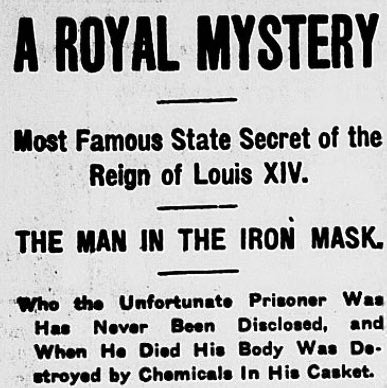
Who was the man in the iron mask? That is a question that has been asked, and unanswered, for over 300 years.
The following article, providing some common guesses as to the identity of the masked man, was published in 1916.

A Royal Mystery – The Man in the Iron Mask
A famous state mystery of the reign of Louis XIV of France was the mysterious prisoner, the Man in the Iron Mask. Many are the guesses which have been ventured as to who he was. Plays and novels have been written with the iron mask as the central character, but his identity has remained a secret. It is known without doubt that St. Mars during his life had as a prisoner a man whose face always was covered with a mask of black velvet fastened by springs of steel behind the head.
The guards had orders to kill the man if he ever exposed his face, and St. Mars depended on nobody finding out who his prisoner was. His first prison was the castle of Pignerol. When St. Mars was transferred to the isles of St. Marguerite the king himself told the jailer to take his prisoner with him and cautioned him not to let him speak to any one, even his guards.
On the night of April 29, 1674, a closed litter escorted by a troop of horses stopped at Bron, some leagues from Lyons. From the litter descended a young man of slim and active figure, his face hidden by a mask and his hands firmly tied, in which state he lay down on a couch prepared beforehand. Next day ten horsemen arrived with sealed orders to convey the prisoner with the utmost secrecy to the fortress of Pignerol. So it was the Man in the Iron Mask began his twenty-nine years of captivity under the impassive, silent, remorseless St. Mars.
Several years later the man of the mask was seen again when St. Mars was transferred to St. Marguerite. This time troopers surrounded a chair covered with waxed cloth. The travelers stopped at an inn for supper. The more daring of the curious peasants peaked through a small window from outside the locked supper room. The prisoner sat with his back to the window, and they could not tell whether he had on his mask. St. Mars sat opposite him with a pistol on each side of his plate.
This prisoner was the subject of much correspondence between St. Mars and Louis XIV of France. Louis continually was asking about him. He gave full instructions as to the care of the man, and about the cell he was to occupy the king wrote:
“Let there be so many doors closed one after the other that the sentinels cannot hear a word, and you will never listen to anything he has to say on any pretext whatever. Threaten him with death if he ever opens his mouth to speak of anything but of what he may be absolutely in want of.”
The blindly obedient St. Mars followed his instructions carefully. The doctor who waited on the prisoner said he had never seen his face, although he had examined his tongue. Dishes and plates were examined each time the prisoner was served to see if there was any writing on them. The guards always were ready to kill the moment he took off his mask.
In other respects the greatest attention was shown him, and nothing which he requested was refused. He always was dressed in black. St. Mars himself stood uncovered in his presence and remained standing until the prisoner had requested him to be seated. The jailer often took his meals with the prisoner.
Just who was the Man in the Iron Mask? Some thought he was an illegitimate son of Anne of Austria. Others said he was a twin brother of Louis XIV, whose claims might have deprived the king of his throne. Another writer makes him the leader of an association which was formed to assassinate the ruler. The most general belief is that he was Count Mattioli, first minister of the Duke of Mantua, who had betrayed the interests of Louis XIV by failing to secure for him, as he had pledged himself to do in consideration for a bribe, possession of the fortress of Casale from his master. Louis XIV knew the secret, but to all questions replied that if it was known who the prisoner was every one would be surprised to find him so uninteresting a person.
The prisoner died after a short illness in 1703. He was buried one autumn day, and his name was inserted in the prison register as M. de Marchiel.
Eighty-six years later the frenzied citizens of Paris broke into the Bastille and rushed to the cell where it was known he had been kept. They stopped short before clean whitewashed walls. Nothing was in the room. The prisoner’s clothes and the mask had been burned when he died. Chemicals had been put in his casket to destroy the body. Only one man had seen the face behind the iron mask during the twenty-nine years. He was St. Mars. And St. Mars never told.
Source: The Devils Lake world and inter-ocean. (Devils Lake, N.D.), 09 March 1916.

